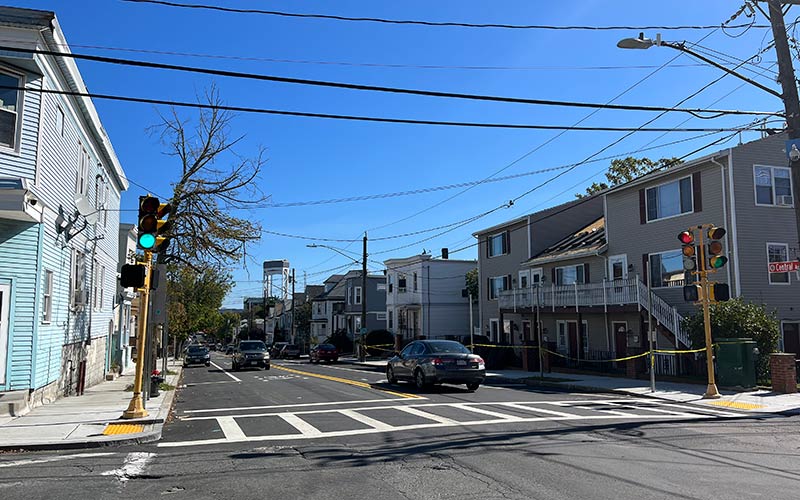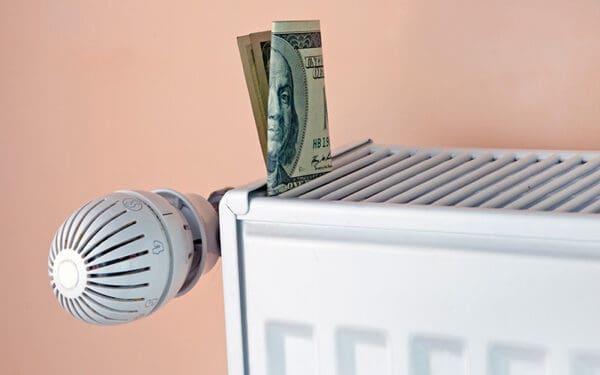
Chelsea, Massachusetts has lots of gas leaks, not enough thriving trees, and too many dangerously hot days. Photo: Sarah White
Imagine standing on an open slab of asphalt on a hot summer day. There are no trees or any other plants around. Everywhere you look, there’s just concrete and tall buildings. Now imagine being outside on an equally sunny day, but instead of scorching blacktop and unfiltered sunlight, you’re standing in a patch of grass under an enormous oak on a tree-lined street.
You probably instinctively understand that you would enjoy the second option much more, but you might not know all the reasons why. Blame a phenomenon known as the “urban heat island” or the “heat island effect.” Towering buildings and heat-absorbing materials like concrete contribute to higher temperatures in city settings. Without protective features like green spaces and thriving tree canopies, temperatures can spiral to risky highs.
Many factors contribute to one neighborhood being more prone to heat island effect than another. But we’ve uncovered one reason why tree canopies suffer in some neighborhoods: Methane leaks from aging gas pipelines that suffocate tree roots, killing trees that could otherwise help keep streets cool.
The secret role of methane in heat islands
Methane can make it impossible to grow thriving trees in urban neighborhoods, particularly in Boston. Aging gas pipelines snake under our neighborhoods to deliver gas to homes and businesses. But those pipelines often leak methane, which removes oxygen and moisture in the soil, smothering tree roots. With its roots dead, a tree might remain standing, but as only a husk, its branches barren of leaves year-round.
National Grid, the primary supplier of natural gas for much of New England, consistently fails to repair its leaking gas pipelines in a timely manner, leading to widespread, decades-old leaks that destroy much-needed tree canopies.
According to the EPA, a lack of trees and green spaces is a key cause of heat islands. Studies show that streets without trees can experience a spike in temperature of seven degrees or more. Surface temperatures can increase by as much as 66 degrees. Think about the difference between a balmy day in the mid-70s and sweating through temps in the 80s.
By providing shade and cooling the air through transpiration, which releases water vapor from leaves, trees can substantially lower temperatures around them. In fact, a strong tree canopy correlates with lower energy bills and lower rates of heat-related illness.
CLF has spent years researching methane leaks in Greater Boston, with shocking results. Our investigators discovered hundreds of unaddressed leaks across the area, some severe enough to potentially cause explosions (investigators alerted authorities as needed). Ailing and dying street trees had much higher average concentrations of methane in their soil.
A fossil fuel company’s neglect of its own infrastructure is silently sabotaging communities.
The dangers of heat islands
Heat islands are more than just uncomfortable for the people living and working in them. Excessive heat can cause heat stroke and dehydration. It also contributes to countless health conditions, including blood clots, strokes, and heart attacks.
Heat islands also worsen air pollution, which in turn worsens respiratory diseases like asthma. That means more doctors’ and hospital bills, sick days at work, and missed school.
Intense heat also correlates to worse test scores in schools and worse mental health. What’s more, people living in heat islands have to pay inflated air conditioning bills, if they can afford AC at all.
With climate change overheating the planet and heat-related deaths rising across the board, preventing heat islands is only growing more crucial.
Heat islands are worse in less wealthy, less white communities
If you know anything about how environmental issues often play out, you won’t be surprised to hear that lower-income, communities of color suffer the worst from extreme heat. Black people in particular are 40% more likely to live in neighborhoods with increasing rates of heat-related illnesses.
Heat islands pose a particular danger to low-income communities where people are less likely to be able to afford air conditioning and more likely to work in manual labor jobs that keep them outside in blazing temperatures. The same conditions aggravated by extreme heat are also more common in lower-income, communities of color.
How CLF is fighting the methane leaks contributing to deadly heat islands
For years, National Grid has gotten away with letting their gas pipelines deteriorate beneath our streets, dumping toxic, planet-warming gas into the atmosphere and choking the roots of vulnerable trees. CLF is stopping it.
We’ve sued National Grid for failing to protect communities from methane leaks. Plaintiffs include residents of neighborhoods impacted by gas leaks and grassroots environmental organizations. If we succeed, National Grid will have to make long overdue repairs to stop the gas leaks.
It’s past time for National Grid to clean up its mess and transition away from fossil fuels altogether. With much safer alternatives like geothermal energy available, there’s no reason to keep dangerous methane flowing. By holding fossil fuel companies accountable, we can fight heat islands in Greater Boston and give residents the clean, safer energy, thriving tree canopies, and cooler, healthier neighborhoods that they deserve.



